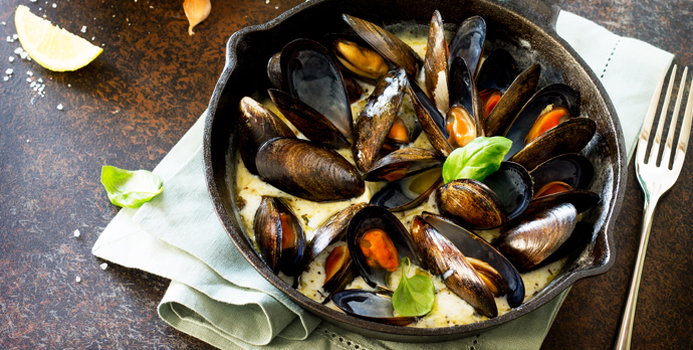The American Heart Association (AHA) is now recommending that you eat at least two servings of fish (especially fatty fish) per week. A serving is about 3.5 ounces of cooked fish, which is about the same size as your checkbook. Fatty fish, which includes salmon, herring, albacore tuna, trout, sardines, mackerel, anchovies, and halibut, are full of omega-3 fatty acids, which are superior for heart and brain health. Shellfish and leaner white fish should also be included each week.
Keep it in Stock
Seafood in cans or pouches, such as canned tuna or salmon in easy tear-off pouches, are shelf-stable, can be stored in your pantry for several years, and are easy to prepare. Tuna salad (made with nonfat Greek yogurt or light mayo instead of full-fat mayonnaise) can be a quick, easy lunch addition to your salad, and pan-seared salmon patties are quick, healthy, and delicious for a weeknight dinner alongside some grilled veggies.
Look for Affordable Seafood Options
Some fish varieties can be incredibly expensive, but that does not mean you have to cross fish off of your healthy grocery list. Often you can find large bags of frozen fish for much less than the same options at the fish counter, and keep an eye out for weekly sales and stock up then. Budget-friendly types of seafood include mackerel, catfish, mussels, shrimp, farm-raised trout, cobia, black sea bass, and drum fish. Canned seafood is probably the most affordable option, so stock up on these to always have some on hand.
Prepare it in a Lean Way
Bake, roast, grill or broil your fish of choice to keep it lean. If you bread and deep-fry your fish, or you cook it in a heavy cream or butter-based sauce, you would be adding extra fat and calories you do not need.
Season it With Your Favorite Flavors
A lot of recipes that call for chicken would be delicious if you use fish instead. Use flavor combinations and sauces that you would typically use with your chicken dishes, and sub in a very mild-tasting fish, such as tilapia or cod. Citrus and chili powder work well on most white fish, and a little maple syrup mixed with Dijon mustard pairs really well with grilled salmon or trout.
Parchment Pouches
One of the easiest and most flavorful ways to cook seafood while keeping it moist without adding a lot of fat is to cook it “en papillote,” which means “in paper.” This moist-heat method of cooking is simple, requires little to no clean-up, and gives you flavorful, perfectly-cooked fish every time. You simple season your fish with herbs, spices, aromatics, and perhaps a few slices of lemon, toss in some vegetables, seal it in a parchment paper or foil pouch (be sure to seal it and fold in the sides), and place it in the preheated oven. You can add a little liquid, such as lemon juice, lime juice, or olive oil, to impart flavor, but it’s not necessary. The ingredients inside steam-cook themselves.
Pair it With Pasta
Spruce up your pasta with flavorful seafood. Whole-grain pasta is a great vehicle for introducing more seafood into your diet because most people already know how to cook and season pasta, and it makes for great leftovers. Shrimp and scallops are easy, tasty pasta additions, as well as tuna and salmon. Add in tons of colorful vegetables and toss it in red sauce, such as marinara or Pomodoro sauce, to keep it light.
Serve It In A Soup or Stew
Preparing soups and stews with fish is an effortless way to integrate more fish into your eating pattern. Starting with a flavorful broth and adding savory vegetables, herbs, and spices will establish a nice base for a seafood soup. Try starting off by making the classic fisherman’s stew cioppino, a San Franciscan staple.
Fish Tacos, Anyone?
Fish tacos are a delicious staple on the West coast, and they should be a dish you add to your weekly culinary repertoire. Enjoying fish tacos is a wonderful way to introduce more servings of fish into your diet if you don’t currently each much of it. You can easily grill a fillet of white fish, shred the fillet into flakes, and serve in shells or soft tortillas with all the fixin's — pico de gallo, salsa, shredded slaw, light sour cream, beans, fresh chopped cilantro, and a squeeze of lime juice. Delicioso!
Swap out That Boring Chicken Salad
Chicken salad is a weekday lunchtime staple because it is easy to make in advance and you can easily take it with you to work and serve with crackers, in a whole-grain wrap or lettuce leaf wrap, or between two pieces of whole-grain toast. Swap out shredded chicken for canned tuna or salmon.
Be Mindful of Mercury
Be sure to choose low-mercury options for fish you’ll consume frequently, and save the higher-mercury fish for just occasional consumption. Options for fish that are low in mercury are generally shellfish and smaller fish, including cod, haddock, herring, pollock, tilapia, trout, sardines, anchovies, and others. For more details about fish and mercury, check out the U.S. Food and Drug Administration’s chart.
[Image via Shutterstock]



